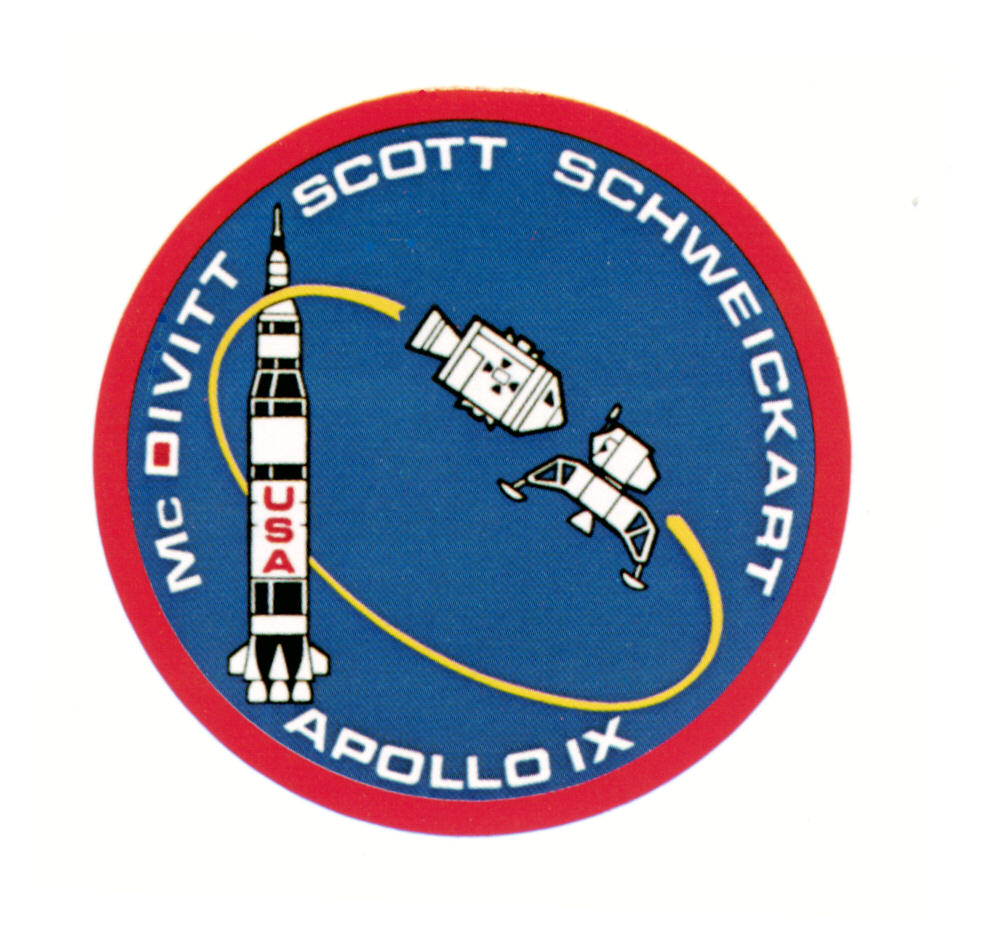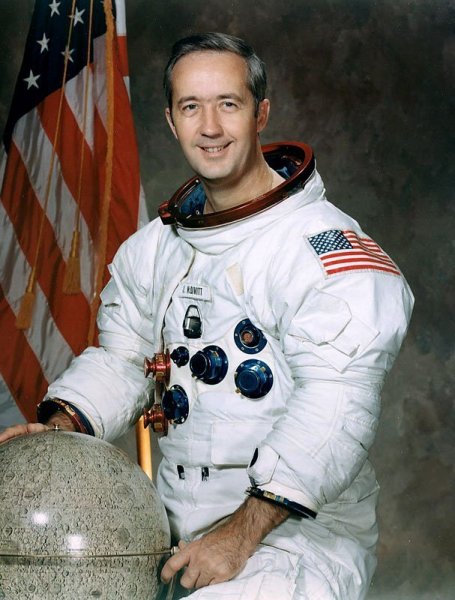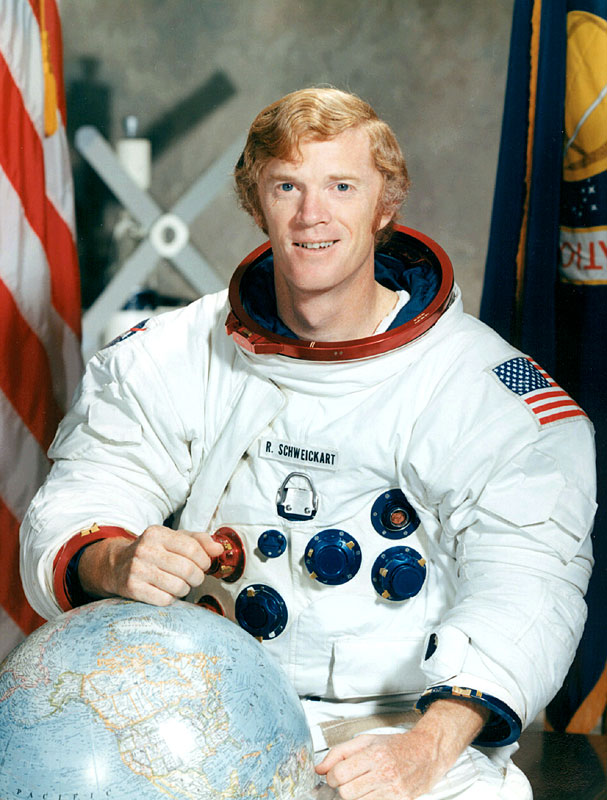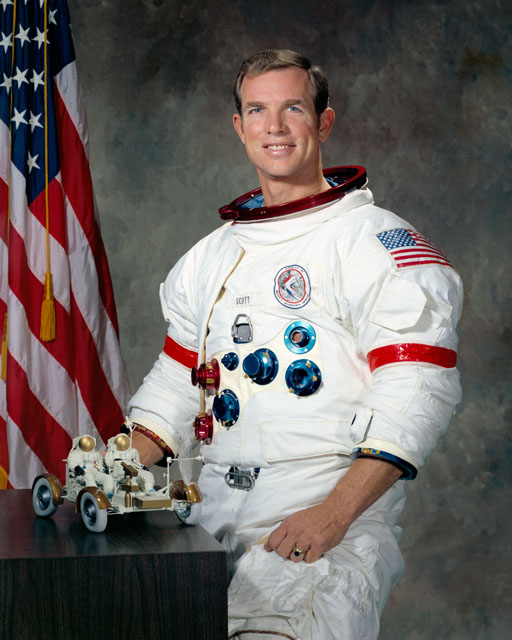
|
||||||||||||
|
|
Apollo 9
First crewed Lunar Module test Splashdown 13 March 1969 Astronauts Russell L. Schweickart, David R. Scott, and James A. McDivitt.
Apollo 9 was the third crewed Apollo flight and the first crewed flight to include the Lunar Module (LM). The crew was Commander James McDivitt, Command Module (CM) pilot David Scott, and LM pilot Russell Schweickart. The primary objective of the mission was to test all aspects of the Lunar Module in Earth orbit, including operation of the LM as an independent self-sufficient spacecraft and performance of docking and rendezvous manuevers. The goal was to simulate maneuvers which would be performed in actual lunar missions. Other concurrent objectives included overall checkout of launch vehicle and spacecraft systems, crew, and procedures. A multispectral photographic experiment was also performed. Apollo 9 was composed of a command module, a command service module (CSM), a lunar module, and an instrument unit (IU), and was launched by a Saturn V rocket. The vehicle rocket had three stages, S-IC, S-II, and S-IVB. The CM, a cone-shaped craft about 390 cm in diameter at the large end, served as a command, control, and communications center. Supplemented by the SM, it provided all life support elements for the three crewmen. The spacecraft mass of 26,801 kg is the mass of the CSM including propellants and expendables. The CM was capable of attitude control about three axes and some lateral lift translation. It permitted LM attachment and CM/LM ingress and egress and served as a buoyant vessel at sea. The CSM provided the main propulsion and maneuvering capability. It was jettisoned just before CM reentry. The CSM was a cylinder 390 cm in diameter. The LM was a two-stage vehicle that accommodated two men and could transport them to the lunar surface. It had its own propulsion, communication, and life support systems. After launch and injection of the combined S-IVB stage and the adaptor-LM-CSM payload into a 189.6 x 192.5 km Earth orbit, the S-IVB propellant tanks were vented, changing the orbit to 198 x 204 km. At 2:41 after launch the CSM separated from the S-IVB and and the adaptor panels were jettisoned, exposing the LM mounted on the S-IVB. The CSM turned around and docked with the LM at 3 hours after launch. At 4 hours after launch the S-IVB and CSM-LM were separated and the S-IVB had a 62 second burn to raise its apogee to 3050 km. Over the next few days the CSM service propulsion system (SPS) was fired five times to change the orbit to prepare for rendezvous manuevers and test the dynamics of the CSM and LM under thrust. The LM descent engine was also fired for 367 seconds on 5 March. On 6 March Schweickart conducted a 37.5 minute EVA on the LM porch to test the astronaut's portable life support system and extravehicular mobility unit. At the same time Scott performed an EVA from the CSM side hatch. On 7 March at 13:03 UT, the LM, carrying McDivitt and Schweickart, separated from the CSM. It was put into a circular orbit about 20 km higher than the CSM. The LM descent stage was jettisoned and for the first time in space the ascent stage engine was fired, lowering the LM orbit to 16 km below and 120 km behind the CSM. A simulated rendezvous of the LM returning from a lunar mission with the orbiting CSM culminated in docking at 19:02 UT. The crew transferred back to the CSM, The LM ascent stage (1969-018C) was jettisoned and its ascent engine was commanded to fire to fuel depletion, into an Earth orbit of 235 x 6970 km. The LM ascent stage orbit decayed on 23 October 1981, the LM descent stage (1969-018D) orbit decayed 22 March 1969. The remaining four days included more orbital manuevers and a landmark tracking exercise. All systems on all spacecraft worked nearly normally during the mission, and all primary objectives were accomplished. Apollo 9 splashed down in the Atlantic Ocean on 13 March 1969 at 17:00:54 UT (12:00:54 p.m. EST) after a mission elapsed time of 241 hrs, 0 mins, 54 secs. The splashdown point was 23 deg 15 min N, 67 deg 56 min W, 180 miles east of Bahamas and within sight of the recovery ship USS Guadalcanal. The Apollo 9 Command Module "Gumdrop" is on display at the San Diego Aerospace Museum in San Diego, California.
James A. McDivitt (Brig. General, USAF Ret.) PERSONAL DATA: Born June 10, 1929, in Chicago, Illinois. His mother Mrs. James McDivitt, resides in Jackson, Michigan. Married. Four children and two step-children. Recreational interests include hunting, fishing, golf, water sports, tennis, and all outdoor activities. EDUCATION: Graduated from Kalamazoo Central High School, Kalamazoo, Michigan; Jackson Junior College, Jackson, Michigan, received a Bachelor of Science degree in Aeronautical Engineering from the University of Michigan (graduated first in class) in 1959 and an Honorary Doctorate in Astronautical Science from the University of Michigan in 1965; Honorary Doctor of Science, Seton Hall University, 1969; Honorary Doctor of Science, Miami University (Ohio), 1970; Honorary Doctor of Laws, Eastern Michigan University, 1975. ORGANIZATIONS: Member of the Society of Experimental Test Pilots, the American Institute of Aeronautics and Astronautics, Tau Beta Pi, and Phi Kappa Phi. Atlantic Council on Foreign Diplomacy, Advisory Council-University of Michigan. SPECIAL HONORS: Awarded two NASA Distinguished Service Medals; NASA Exceptional Service Medal; two Air Force Distinguished Service Medals; four Distinguished Flying Crosses; five Air Medals; the Chong Moo Medal from South Korea; the USAF Air Force Systems Command Aerospace Primus Award; the Arnold Air Society JFK Trophy; the Sword of Loyola; and the Michigan Wolverine Frontiersman Award, USAF Astronaut Wings. EXPERIENCE: McDivitt joined the Air Force in 1951 and retired with the rank of Brig. General. He flew 145 combat missions during the Korean War in F-80s and F-86s. He is a graduate of the USAF Experimental Test Pilot School and the USAF Aerospace Research Pilot course and served as an experimental test pilot at Edwards Air Force Base, California. He has logged over 5,000 flying hours. NASA EXPERIENCE: General McDivitt was selected as an astronaut by NASA in September 1962. He was command pilot for Gemini 4, a 66-orbit 4-day mission that began on June 3, and ended June 7, 1965. Highlights of the mission included a controlled extra-vehicular activity period and a number of experiments. He was commander of Apollo 9, a 10-day earth orbital flight launched on March 3, 1969. This was the first flight of the complete set of Apollo hardware and was the first flight of the Lunar Module. He became Manager of Lunar Landing Operations in May 1969, and led a team that planned the lunar exploration program and redesigned the spacecraft to accomplish this task. In August 1969, he became Manager of the Apollo Spacecraft Program and was the program manger for Apollo 12, 13, 14, 15 and 16. He retired from the USAF and left NASA in June 1972, to take the position of Executive Vice-President, Corporate Affairs for Consumers Power Company. In March 1975, he joined Pullman, Inc. as Executive Vice-President and a Director. In October 1975 he became President of the Pullman Standard Division, The Railcar Division, and later had additional responsibility for the leasing and engineering and construction areas of the company. In January 1981 he joined Rockwell International where he is presently Senior Vice President, Government Operations and Rockwell International Corporation, Washington, D.C.
Russell L. Schweickart Russell L. (Rusty) Schweickart is a retired business and government executive and serves today as Chairman of the Board of the B612 Foundation. The organization, a non-profit private foundation, champions the development and testing of a spaceflight concept to protect the Earth from future asteroid impacts. Schweickart retired from ALOHA Networks, Inc. in 1998 where he served as President and CEO from 1996 through 1998. ALOHA was a data communications company specializing in high performance, wireless internet access equipment. Schweickart was formerly the Executive Vice President of CTA Commercial Systems, Inc. and Director of Low Earth Orbit (LEO) Systems. Schweickart led CTA’s efforts in developing the GEMnet system, a second generation LEO communication satellite constellation designed to provide regular commercial electronic messaging services on a global basis. Prior to his CTA work Schweickart founded and was president of Courier Satellite Services, Inc., a global satellite communications company which developed LEO satellites to provide worldwide affordable data services Schweickart's satellite and telecommunications work involved him in the development of international communications regulations and policies, including participation in the 1992 and 1995 World Radiocommunications Conferences (WRC) of the International Telecommunications Union (ITU). He served at the 1995 WRC as a U.S. delegate. He also worked extensively in Russia and the former Soviet Union on scientific and telecommunications matters. Schweickart is the founder and past president of the Association of Space Explorers (ASE), the international professional society of astronauts and cosmonauts. The organization promotes the cooperative exploration and development of space and the use of space technology for human benefit. The ASE has a current membership of over 300 astronauts and cosmonauts from 29 nations. The Association's first book, The Home Planet, with a preface by Schweickart, was published simultaneously in 10 nations in the Fall of 1988 and was an immediate international best seller. In 1987-88, Schweickart chaired the United States Antarctic Program Safety Review Panel for the Director of the National Science Foundation (NSF) in Washington, DC. The resulting report, Safety in Antarctica, a comprehensive on-site review of all U.S. activities in Antarctica, led to a restructuring of the program, increasing the safety of operations in that hazardous environment. At the request of the National Science Foundation, Schweickart also served on the 1997-1998 United States Antarctic Program Outside Review Panel, which reported to the Whitehouse (OSTP) and Congress on the future of US facilities in Antarctica. The US’ Amundson-Scott South Pole station has recently been fully rebuilt as a result of this work. In 1977 Schweickart joined the staff of Governor Jerry Brown of California, and served in the Governor's office for two years as his assistant for science and technology. In 1979 Schweickart was appointed to the post of Commissioner of Energy for the State of California and served on the Commission for five and a half years. The Commission, which was chaired by Schweickart for three and a half years, was responsible for all aspects of energy regulation in the state other than rate setting, including energy demand forecasting, alternative energy development, powerplant siting and energy performance regulation for appliances and buildings. Schweickart joined NASA as one of 14 astronauts named in October 1963, the third group of astronauts selected. He served as lunar module pilot for Apollo 9, March 3-13, 1969, logging 241 hours in space. This was the third manned flight of the Apollo series and the first manned flight of the lunar module. During a 46 minute EVA Schweickart tested the portable life support backpack which was subsequently used on the lunar surface explorations. On the mission with Schweickart were commander James A. McDivitt and command module pilot David R. Scott. Schweickart served as backup commander for the first Skylab mission which flew in the Spring of 1973. Following the loss of the thermal shield during the launch of the Skylab vehicle, he assumed responsibility for the development of hardware and procedures associated with erecting the emergency solar shade and deployment of the jammed solar array wing, operations which transformed Skylab from an imminent disaster to a highly successful program. After the Skylab program, Schweickart went to NASA Headquarters in Washington, DC as Director of User Affairs in the Office of Applications. In this position he was responsible for transferring NASA technology to the outside world and working with technology users to bring an understanding of their needs into NASA. Prior to joining NASA, Schweickart was a research scientist at the Experimental Astronomy Laboratory of the Massachusetts Institute of Technology (MIT). His work at MIT involved research in upper atmospheric physics, star tracking and the stabilization of stellar images. His thesis for a master's degree at MIT was an experimental validation of theoretical models of stratospheric radiance. Schweickart served as a fighter pilot in the U.S. Air Force and the Massachusetts Air National Guard from 1956 to 1963. He has logged over 4000 hours of flight time, including 3500 hours in high performance jet aircraft. Schweickart was awarded the NASA Distinguished Service Medal (1969) and the Federation Aeronautique Internationale De La Vaux Medal (1970) for his Apollo 9 flight. He also received the National Academy of Television Arts and Sciences Special Trustees Award (Emmy) in 1969 for transmitting the first live TV pictures from space. In 1973 Schweickart was awarded the NASA Exceptional Service Medal for his leadership role in the Skylab rescue efforts. He is a Fellow of the American Astronautical Society and the International Academy of Astronautics, and an Associate Fellow of the American Institute of Aeronautics and Astronautics. Schweickart is an Honorary Trustee and a Fellow of the California Academy of Sciences. Schweickart was born on 25 October 1935 in Neptune, NJ. He is married to Nancy Ramsey of West Hartford, CT. He has seven children and eleven grandchildren. He graduated from Manasquan High School, NJ; received his Bachelor of Science degree in 1956 and his Master of Science degree in 1963, both from the Massachusetts Institute of Technology. His hobbies include golf, bicycling, and hiking.
David R. Scott (Colonel, USAF, Ret.) NASA Astronaut (former) PERSONAL DATA: Born June 6, 1932, in San Antonio, Texas. Married. Two children. Recreational interests include swimming, handball, skiing, and photography. EDUCATION: Graduated from Western High School, Washington, D.C.; received a Bachelor of Science degree from the United States Military Academy and the degrees of Master of Science in Aeronautics and Astronautics and Engineer in Aeronautics and Astronautics from the Massachusetts Institute of Technology; awarded an Honorary Doctorate of Astronautical Science from the University of Michigan in 1971. He has graduated from the Air Force Experimental Test Pilots School and Aerospace Research Pilots School. ORGANIZATIONS: Scott is a fellow of the American Astronautical Society, Associate fellow of the American Institute of Aeronautics and Astronautics, and member of the Society of Experimental Test Pilots, and Tau Beta Pi, Sigma Xi and Sigma Gamma Tau. SPECIAL HONORS: Two NASA Distinguished Service Medals, the NASA Exceptional Service Medal, two Air Force Distinguished Service Medals, the Air Force Distinguished Flying Cross, the Air Force Association's David C. Schilling Trophy and the Robert J. Collier Trophy for 1971. EXPERIENCE: Scott graduated fifth in a class of 633 at West Point and subsequently chose an Air Force career. He completed pilot training at Webb Air Force Base, Texas, in 1955 and then reported for gunnery training at Laughlin Air Force Base, Texas, and Luke Air Force Base, Arizona. He was assigned to the 32d Tactical Fighter squadron at Soesterberg Air Base (RNAF), Netherlands, from April 1956 to July 1960. Upon completing this tour of duty, he returned to he United States for study at the Massachusetts Institute of Technology. He retired from the Air Force in March 1975 with the rank of Colonel and over 5600 hours of flying time. NASA EXPERIENCE: Scott was one of the third group of astronauts named by NASA in October 1963. On March 16, 1966, he and command pilot Neil Armstrong were launched into space on the Gemini 8 mission--a flight originally scheduled to last three days but terminated early due to a malfunctioning thruster. The crew performed the first successful docking of two vehicles in space and demonstrated great piloting skill in overcoming the thruster problem and bringing the spacecraft to a safe landing. Scott served as command module pilot for Apollo 9, March 3-13, 1969. This was the third manned flight in the Apollo series, the second to be launched by a Saturn V, and the first to complete a comprehensive earth-orbital qualification and verification test of a "fully configured Apollo spacecraft." The ten-day flight provided vital information previously not available on the operational performance, stability, and reliability of lunar module propulsion and life support systems. Highlight of this evaluation was completion of a critical lunar-orbit rendezvous simulation and subsequent docking, initiated by James McDivitt and Russell Schweickart from within the lunar module at a separation distance which exceeded 100 miles from the command/service module piloted by Scott. The crew also demonstrated and confirmed the operational feasibility of crew transfer and extravehicular activity techniques and equipment, with Schweickart completing a 46-minute EVA outside the lunar module. During this period, Dave Scott completed a 1-hour stand-up EVA in the open command module hatch photographing Schweickart's activities and also retrieving thermal samples from the command module exterior. Apollo 9 splashed down less than four miles from the helicopter carrier USS GUADALCANAL. In his next assignment, Scott was designated backup spacecraft commander for Apollo 12. He made his third space flight as spacecraft commander of Apollo 15, July 26 - August 7, 1971. His companions on the flight were Alfred M. Worden (command module pilot) and James B. Irwin (lunar module pilot). Apollo 15 was the fourth manned lunar landing mission and the first to visit and explore the moon's Hadley Rille and Apennine Mountains which are located on the southeast edge of the Mare Imbrium (Sea of Rains). The lunar module, "Falcon," remained on the lunar surface for 66 hours and 54 minutes (setting a new record for lunar surface stay time) and Scott and Irwin logged 18 hours and 35 minutes each in extravehicular activities conducted during three separate excursions onto the lunar surface. Using "Rover-1" to transport themselves and their equipment along portions of Hadley Rille and the Apennine Mountains, Scott and Irwin performed a selenological inspection and survey of the area and collected 180 pounds of lunar surface materials. They deployed an ALSEP package which involved the emplacement and activation of surface experiments, and their lunar surface activities were televised using a TV camera which was operated remotely by ground controllers stationed in the mission control center located at Houston, Texas. Other Apollo 15 achievements include: largest payloads ever placed into earth and lunar orbits; first scientific instrument module bay flown and operated on an Apollo spacecraft; longest distance traversed on lunar surface; first use of a lunar surface navigation device (mounted on Rover-1); first subsatellite launched in lunar orbit; and first extravehicular (EVA) from a command module during transearth coast. The latter feat performed by Worden during three excursions to "Endeavour's" SIM-bay where he retrieved film cassettes from the panoramic and mapping cameras and reported his personal observations of the general condition of equipment housed there. Apollo 15 concluded with a Pacific Ocean splashdown and subsequent recovery by the USS OKINAWA. He has logged 546 hours and 54 minutes in space, of which 20 hours and 46 minutes were in Extravehicular Activity. He is only one of three Astronauts who have flown both earth orbital and lunar Apollo Missions. Credit NASA |






